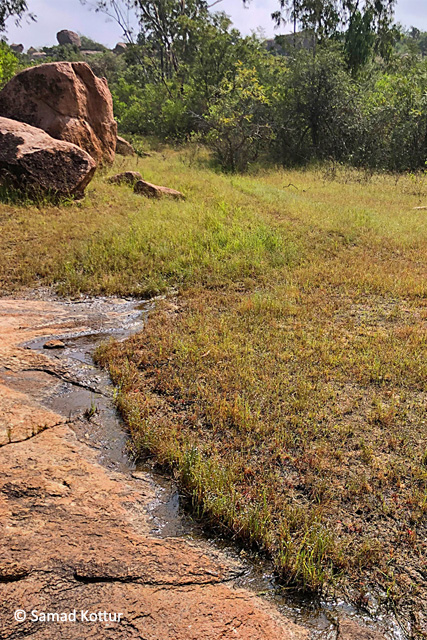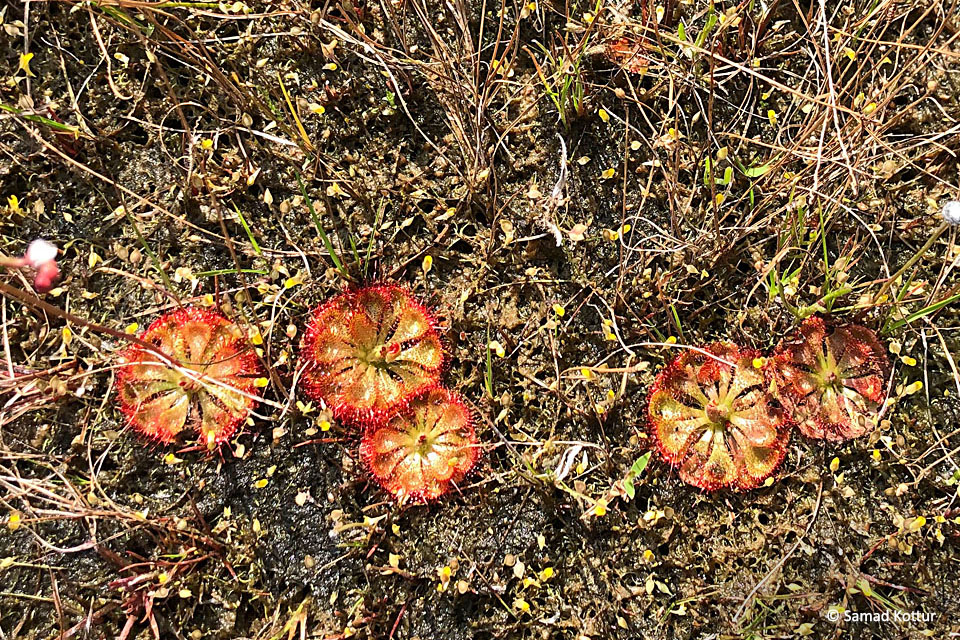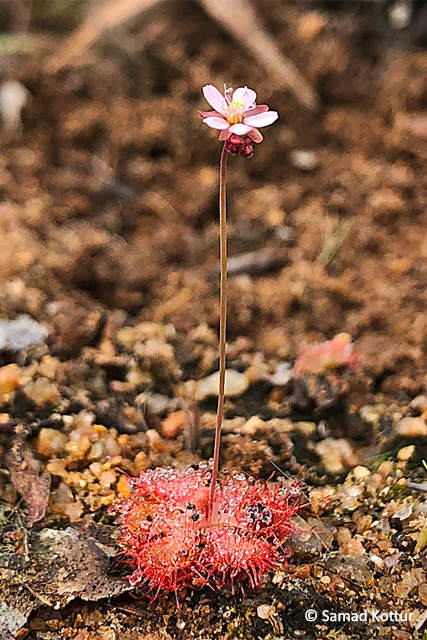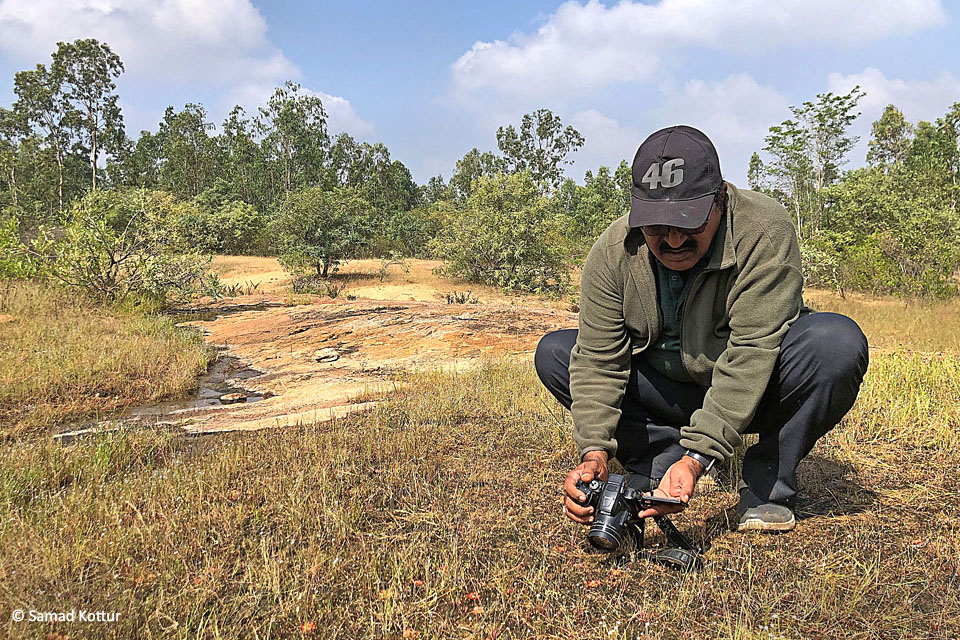The web of life is very strange and its ways are astonishing. The more you dig into nature, the more inquisitive and humbled you become to find so much hidden in the backyard! The drier eastern plains of North Karnataka are great to explore and appreciate some amazing biodiversity. During my school and college days, our teachers astonished us with a beautiful diagram of a plant that eats insects. It felt natural that animals eat plants, but here was a plant that eats animals – a carnivorous or insectivorous plant! All of them told us that it was a rare plant, but none of them told us where the plant existed, nor did they show us a specimen of it.
After almost a quarter of a century, I happened to see this plant in the wild. In 2010, while conducting rapid biodiversity assessment and documentation for proposing the formation of Gudekote Bear Sanctuary, I accidentally found this plant. To collect evidence of Sloth Bear movement in Gudekote, I visited a nearby forest; I found the scat of Sloth Bears as well as their hair trapped in the barbed wire fence along a stream. I went on to find more such evidence along another stream nearby. This stream with scanty water had infertile soil and some strange plants along its bank. Curious to know about them, I began observing the strange, pinkish plants, and photographed them with a macro lens. After detailed observation, I was startled to learn that this was the plant our teachers had taught us about – the insectivorous plant, drosera! I was speechless with awe and joy. I had taken some images but did not share it anywhere, as I needed to explore more details about its ecology.

Drosera Sundew (Drosera burmanii Vahl)
Two years later, I visited Gudekote in search of the drosera, but could not find it. Then, for almost a decade, I forgot about this plant. But curiosity resurfaced when I visited Gudekote in 2022. I went in search of the rare, insectivorous plant, but in vain. Had it vanished from there?
Recently, I was trekking in a vast stretch of bear and leopard habitat, in the Anegundi-Hirebenekal-Agoli area in Karnataka’s Koppal District. While walking along a small stream, my sixth sense alerted me to look for drosera in the region’s typical terrain of rocky, sandy-murrum soil surrounded by Eucalyptus trees. Soon enough, I danced with ecstasy – I found hundreds of drosera along the wet banks of the streamlet! Without further delay, I photographed them with my iPhone. I saw an innumerable number of them hidden amongst grasses and weeds.

The habitat along the stream.

Drosera amidst grass and weeds.
The species of drosera I saw is commonly known as ‘sundew’ and its scientific name is Drosera burmanii Vahl. Presently, the colony of Drosera Sundew is found along tiny streams where the soil nutrients are washed away by rain, and the bank contains sand and murrum soil that is leached from ancient rocks. Drosera typically grows in nitrogen deficient soils, and the plant has evolved to get this and other nutrients from insects. This could explain its presence in the region.
One cannot appreciate the beauty of Drosera Sundew with naked eyes. It is smaller than a fifty paisa coin, and to view it well requires either a magnifying glass or a camera with a macro lens. Drosera Sundew is a round, reddish-green plant with flowering stalks. This small, flat plant is just 2 cm diameter, with wedge shaped leaves forming a rosette. A stalk of 5-16 cm length emerges from the centre of the plant, with light pinkish flowers at the top.

Drosera Sundew with its flower.

Photographing the plant is challenging.
The plant’s leaves have hundreds of red, hairy structures, whose tips have tiny drops of sweet nectar to attract ants and small insects. Hence, the plant looks reddish. As soon as an insect comes in contact with the nectar, it gets trapped due to the stickiness. The jerky movements of ants or insects trying to escape make the leaves of the drosera curl up slowly, to encase the prey in its sticky juice, which enables it to be digested by the plant. After the nutrients from the insect are taken, the plant slowly opens up and waits for the next prey. What a strange phenomenon – a reverse food chain, if you will!

Drosera, with insects trapped in them.
There are broadly three types of carnivorous plants in India – Drosera, Pitcher Plant and Utricularia. Drosera is the largest genera, with 194 species. Drosera burmannii is found in India, China, Japan and Southeast Asia. In India, there are reports of Drosera burmannii in West Bengal, Orissa, Maharashtra, and Kerala. In Karnataka, this species has presence in the Western Ghats and in Bannerghatta, Bangalore. It has been flowering in Koppal from September to December, and soon after, the seeds scatter around for germination in the next season.
As sighting this plant in Koppal District or probably even in North Karnataka is very recent, we need to understand its ecology in a prolonged study. I feel elated to be exploring unseen forests and unreported species in the lesser-known but bio-diverse region of North Karnataka.





Instagram
junglelodgesjlr